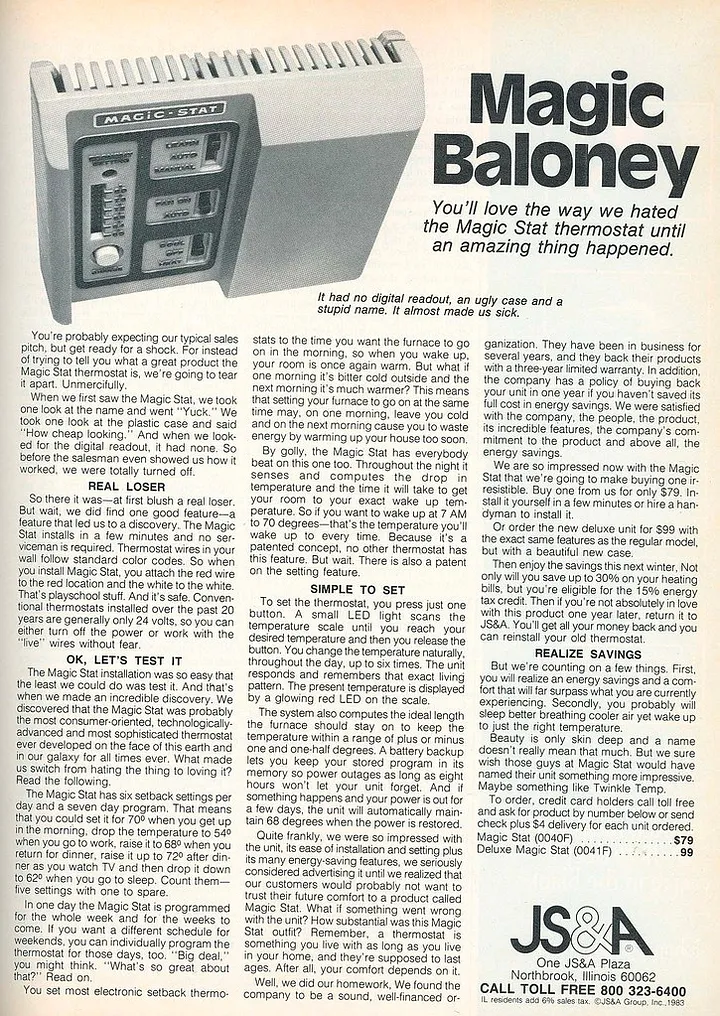How legendary copywriter, Joe Sugarman, used these triggers in his copywriting.

Joe Sugarman is one of the most legendary copywriters.
He once sold a $240,000 airplane in a single mail-order ad. In his most popular book, The Adweek Copywriting Handbook, he shares 25 “psychological triggers” that get people to buy.
This book helped shape my copywriting career more than any other book.
Here’s a breakdown of each psychological trigger and a quote from The Adweek Copywriting Handbook.
The Feeling of Involvement or Ownership Sugarman 🔗
Make the customer use the product before they purchase it.
Make them imagine it’s theirs by using it.
Honesty 🔗
Sugarman was so honest, he once wrote an ad for a digital thermostat that said:
“It had no digital readout, an ugly case, and a stupid name. It almost made us sick.”
Integrity 🔗
Sugarman believed integrity came down to 3 things:
- The look of your ad
- The image that you convey
- The typeface that you use
Credibility 🔗
Honesty and integrity make credibility. Sugarman believed you needed to avoid these 3 things if you want to build credibility:
- Rash statements
- Cliches
- Exaggeration
Value and Proof of Value 🔗
Sugarman knew that consumers were smart enough to know that there are other competitors out there.
It’s your job to bring that up and show them YOUR product is the best value
Justify the Purchase 🔗
Sugarman says if you want to resolve the objection, you need to justify every purchase in your copywriting, even if it’s just “you deserve it.”
Greed 🔗
This means that people will buy things JUST because they are on sale.
Establish Authority 🔗
Give assurance with popular products that make people more comfortable buying from you.
Satisfaction conviction 🔗
Satisfaction conviction should raise an objection and resolve it.
Nature of Product 🔗
For example, a fun toy should convey excitement and joy. A burglar alarm should be easy to install and offer peace of mind.
Current fads 🔗
Fads tend to come quickly and go quickly. So it’s smart to exploit a fad when you see it starting, especially if your timing is right.
Timing 🔗
Sugarman recommends you first test every product you sell before placing a big bet. Consumers tell you if you’re too early, too late, or on target.
Harmonize 🔗
Sugarman says don’t just harmonize with the market, harmonize with your customer.
Desire to Belong 🔗
This is a powerful motivational factor because prospects want to identify with a particular group.
Desire to Collect 🔗
People collect cars, sunglasses, dolls, and whatever else because they have the urge to collect.
Curiosity 🔗
Sugarman says the key to curiosity is holding back part of a story in order to make people curious and create demand.
Sense of urgency 🔗
You can convey a sense of urgency with limited editions. Or listing the wrong price and saying it was going back up in a few days.
Instant gratification 🔗
The closer you can get a person to getting instant gratification, the better they feel about the product.
Exclusivity, Rarity, or Uniqueness 🔗
If there’s a special significance behind a product (and a limited amount), it drives its value up massively.
Simplicity 🔗
Focus on what you’re trying to accomplish and eliminate everything else that complicates it.
- Use simple words
- Keep layouts simple
- Simple typefaces
Human Relationships 🔗
Buying is always an emotional experience. Tell stories because they resonate more with people. Sugarman also says to use as many positive human elements as you can.
Guilt 🔗
For instance, charities would send people free things like stickers or other small gifts in order to kind of “guilt” people into sending in a donation.
Specificity 🔗
Here’s an example Sugarman shows:
- Bad: New dentists everywhere use and recommend CapSnap Toothpaste.
- Good: 92% of new dentists use and recommend CapSnap Toothpaste.
Familiarity 🔗
Sugarman gives these examples:
- Familiar brand logos
- Familiar phrases. (not cliches)
- Familiar copywriting layout
Hope 🔗
Food supplements, lowering your golf score, preventing wrinkles, and other good opportunities are the psychological trigger of hope at work.


